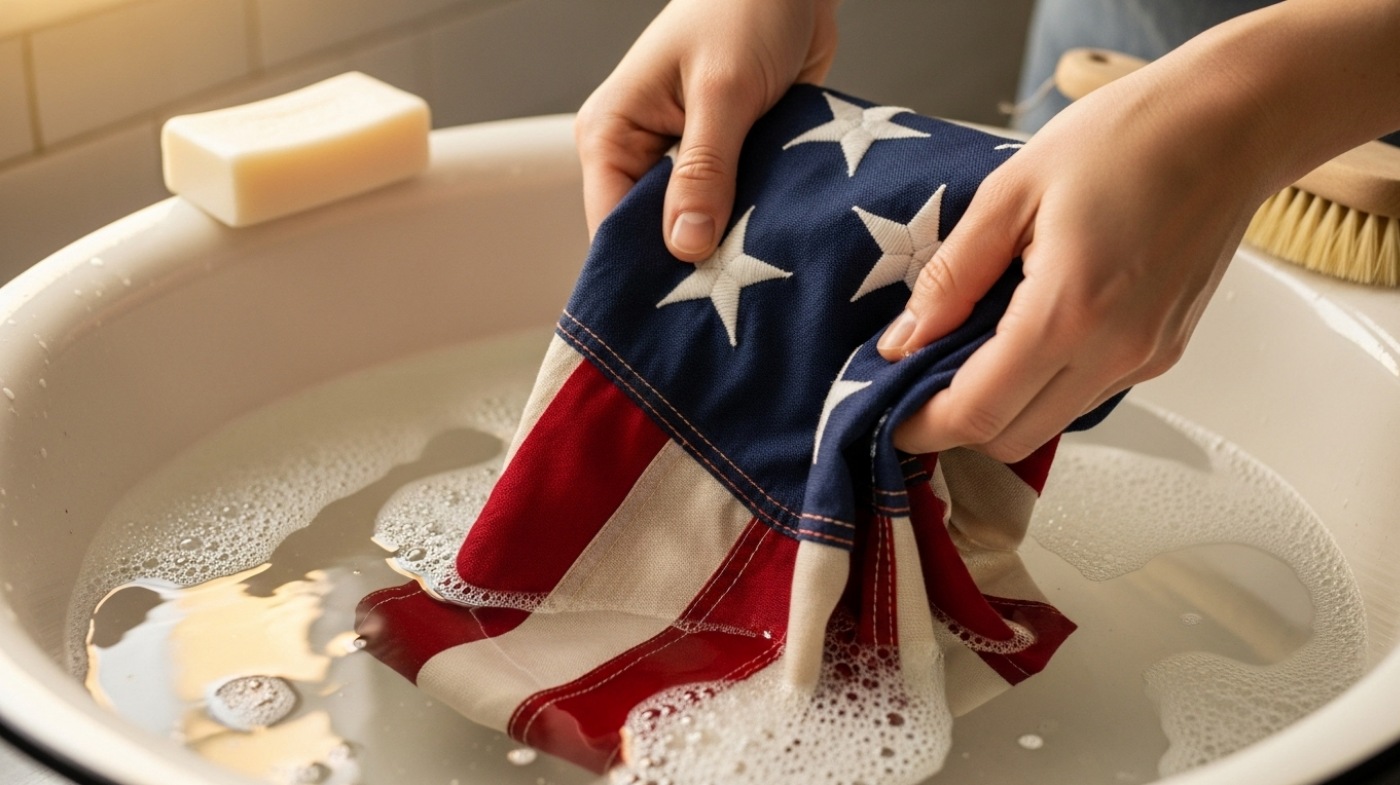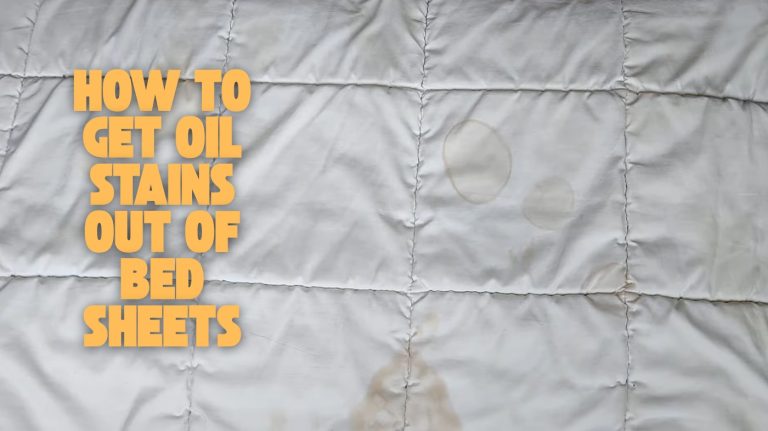Can You Wash a Flag? Safe Methods for Long-Lasting Color
You can wash a flag, but how you do it depends on its fabric. Synthetic flags like nylon or polyester handle gentle machine washing with mild detergent in cold water.
Natural fibers such as cotton or wool need careful hand washing to avoid damage. Never use bleach or harsh chemicals, and always air dry in shade to protect colors.
Handling delicate or ceremonial flags requires extra care to preserve their appearance. Keep going if you want to explore the best practices for each fabric type and special flags.
Key Takeaways
- Yes, flags can be washed, but the method depends on fabric type, with synthetic flags being machine washable and natural fibers requiring gentle hand washing.
- Use mild detergent in cold or lukewarm water, avoiding bleach, fabric softeners, and harsh chemicals to protect color and fabric integrity.
- Machine wash synthetic flags on a gentle cycle inside mesh laundry bags, and always air dry flags away from direct sunlight to prevent fading.
- For delicate, vintage, or ceremonial flags, hand wash carefully or consult a professional conservator to avoid damage.
- Always ensure flags are completely dry before storage, folding loosely or rolling to prevent mold and fabric deformation.
Understanding Different Fabric Types of Flags
When choosing a flag, understanding the fabric type is essential because it directly affects durability, appearance, and care requirements.
Cotton flags offer a traditional look with superior draping, ideal for indoor or ceremonial use due to their softness and vintage appeal. However, they’re vulnerable to mildew, rot, and sun damage outdoors.
Cotton flags provide classic elegance indoors but require care outdoors due to susceptibility to weather damage.
Nylon flags are lightweight, durable, and highly UV-resistant, flying well even in light breezes. Their fast-drying, colorfast nature makes them excellent for outdoor environments.
Polyester flags are heavier and tougher, resisting stains, fading, and harsh weather, making them suitable for year-round outdoor display.
Historically, silk, wool, linen, and hemp were used but lacked longevity outdoors. Knowing these fabric characteristics helps you select the right flag for your setting and care needs.
Proper rinsing and quick drying are also important to prevent damage or residue buildup that can affect fabric integrity, especially in outdoor flags exposed to cleaning agents and moisture. This is a key aspect of preventative cleaning strategies.
Best Washing Methods for Synthetic Flags
How should you clean synthetic flags to maintain their vibrant colors and durability? Start by choosing either machine or hand washing based on the flag’s size and delicacy.
Use cold or warm water and mild detergent, avoiding bleach and fabric softeners that can damage fibers and fade colors. When machine washing, select a gentle cycle and place smaller flags in a mesh laundry bag.
It is important to check the colors first to ensure no bleeding occurs before washing. Additionally, using non-abrasive cleaning tools can help maintain the fabric’s integrity during cleaning.
Always remove the flag promptly after washing to prevent wrinkles.
Keep these tips in mind:
- Hand wash gently without wringing; rinse thoroughly.
- Hang flags to air dry away from direct sunlight; avoid dryers.
- Iron only on low heat if needed, with light pressure.
- Spot clean stains carefully using diluted detergent and a soft cloth.
These methods preserve your synthetic flag’s look and longevity.
Caring for Natural Fiber Flags: Cotton and Wool
When it comes to taking care of your cotton and wool flags, it’s really important to treat them gently. You’ll want to stick to hand-washing, using lukewarm water and a mild detergent to keep those fibers safe. Trust me, machine washing and harsh chemicals are a big no-no—they can really harm these delicate fabrics. After washing, be sure to roll it in a towel to remove excess water instead of wringing, which can damage the fibers.
And hey, if you have a vintage or especially valuable flag, it might be a good idea to think about professional dry cleaning. That way, you can make sure it gets the thorough care it deserves without the risk of damage. Using a mild detergent similar to traditional gentle soaps helps preserve natural fibers while effectively cleaning them.
Gentle Washing Techniques
Although natural fiber flags like cotton and wool require careful handling, you can preserve their quality by using gentle washing techniques tailored to their delicate structure.
To clean your flag without causing damage, focus on minimizing agitation and avoiding harsh chemicals. Here’s how you can proceed:
Soak the flag in cold or lukewarm water with a mild, oxygen-based detergent for at least 4 hours.
Avoid wringing or twisting to prevent fiber distortion and tearing.
Rinse thoroughly with cold water to remove detergent residue and prevent color bleeding.
Air dry flat away from direct sunlight to maintain shape and avoid fading. Be sure to monitor cleaning process closely to avoid damage during washing. Hand washing is advised for natural fiber flags to ensure gentle cleaning.
Dry Cleaning Recommendations
While gentle hand washing can help maintain natural fiber flags like cotton and wool, dry cleaning offers a specialized approach that better protects their delicate structure.
Using solvents instead of water, dry cleaning prevents fiber swelling, shrinkage, and color bleeding, which often occur during washing. Professional cleaners employ techniques that preserve vibrant colors, fabric texture, and seam integrity, extending your flag’s lifespan.
It is important to check fabric type and follow flag care guidelines before choosing any cleaning method. Before dry cleaning, inspect your flag for damage and consider minor repairs. Remove metal attachments to avoid harm during the process.
Afterward, store the flag away from sunlight and handle it carefully while damp. You can ease wrinkles with low heat ironing or steaming, but avoid overheating. Prompt stain treatment using cold water rinsing and gentle detergents is essential to prevent lasting damage before professional cleaning.
Machine Washing Settings and Precautions
When it comes to washing your flag in the machine, it’s best to go for the gentle cycle. This helps to reduce fabric stress and keeps your flag from getting damaged.
Oh, and remember to use cold water for most flags! This is key to preventing any color bleeding. You can save warm water for those more durable synthetics, like polyester.
It’s also very important to handle the flag carefully during washing to avoid any tears or stretching.
Now, when it comes to detergent, opt for a mild liquid one that’s made for delicate fabrics. It’s really important to steer clear of bleach or any harsh chemicals, as they can fade the colors and weaken the fibers.
Gentle Cycle Usage
Since flags made from nylon and polyester handle machine washing well, selecting the gentle cycle becomes essential to safeguard their fabric integrity. The gentle cycle minimizes drum agitation, reducing wear and fraying, especially at seams. This method helps prevent fabric deterioration that can occur with harsher washing cycles. Using the gentle cycle also helps maintain the integrity of delicate fibers by minimizing mechanical stress.
Avoid heavy-duty or permanent press cycles as they stress fabric fibers. Opt for shorter cycles and the lowest spin speed to prevent creasing. If possible, use a front-loading machine for a softer wash action.
Keep these tips in mind:
- Wash the flag alone or with lightweight items to avoid tangling.
- Fold or loosely roll the flag before loading it in the machine.
- Use a mesh laundry bag for added protection against snags.
- Ensure the flag isn’t bunched or twisted inside the drum.
Detergent and Temperature
Choosing the right detergent and water temperature plays a crucial role in preserving your flag’s fabric and colors during washing.
Use a mild, non-abrasive detergent made for delicate fabrics. Avoid bleach, fabric softeners, and optical brighteners that can weaken fibers and fade colors. Selecting a detergent formulated for delicate fabrics ensures effective cleaning without damaging fibers.
For machine washing, always select cold water to prevent color bleeding, especially with synthetic flags like nylon or polyester. Hand washing with delicate detergent is also recommended to maintain fabric quality when possible.
Natural fiber flags (cotton, wool) may tolerate lukewarm water during hand-washing, but cold water remains safest in machines.
Place your flag in a mesh laundry bag to reduce friction, use minimal detergent, and remove it promptly after washing to avoid moisture damage.
Techniques to Preserve Dye and Prevent Color Bleeding
Although preserving the vibrancy of flag dyes during washing can be challenging, using mild detergents specifically formulated for delicate fabrics considerably reduces dye loss and fiber damage.
You should avoid bleach, harsh stain removers, and detergents with optical brighteners or enzymes, as they accelerate fading and alter colors. Temperature control matters; always use cold or lukewarm water, never hot, to prevent dye bleeding. Using gentle cleaning methods also helps to avoid damaging sensitive materials, similar to how unlacquered brass requires careful maintenance to preserve its finish.
Hand washing gently or using the delicate machine cycle also helps maintain color integrity. For delicate or historically important flags, it is advisable to consult a conservator before attempting to clean them.
To preserve your flag’s colors, keep these tips in mind:
Wash flags separately or with like colors to avoid cross-color contamination. Use short wash cycles and rinse promptly to limit dye exposure.
Consider soaking cotton or wool flags briefly in oxygen-based bleach cautiously. Protect flags in mesh bags during machine washes to reduce mechanical stress.
Proper Drying and Post-Wash Handling
When drying your flag, air drying remains the safest method to protect both fabric and color integrity. Regular cleaning preserves the flag’s vibrant colors and appearance.
Hang it horizontally in a shaded, well-ventilated area, avoiding direct sunlight to prevent fading and fiber weakening. Proper airflow around the drying area reduces contamination risks and helps maintain fabric quality.
Spread the flag evenly without folds or creases to ensure uniform drying and avoid deformation.
Keep it away from dust, pollution, or dirt sources to prevent staining.
Avoid machine dryers, as heat can shrink and damage fabric, cause color loss, and deform the flag.
If absolutely necessary, use the lowest heat with a mesh bag and remove while damp.
After washing, gently press out excess water without wringing.
Iron only on low heat with a cloth barrier if needed.
Store the flag fully dry, loosely folded or rolled, to maintain its longevity and prevent mold growth during storage.
Special Considerations for Ceremonial and Custom Flags
Because ceremonial and custom flags often feature delicate fabrics, intricate embellishments, and specialized dyes, you need to handle their cleaning with greater care and attention than standard flags.
Start by inspecting the flag for fragile seams, loose threads, or detachable decorations to avoid damage during washing. Always test a small, hidden area for colorfastness before cleaning. Using gentle cleaning solutions similar to those recommended for delicate fabrics can help preserve the flag’s integrity and prevent damage from harsh chemicals.
Begin by checking for loose threads or decorations and test a hidden spot for colorfastness before cleaning.
Hand-washing with mild detergent is safest, and avoid machine washing unless the flagmaker approves. Consider professional cleaning for valuable or historic flags.
Keep in mind these key precautions:
Remove detachable elements like tassels to prevent tangling. Avoid bleach and fabric softeners that degrade fibers. Store cleaned flags in acid-free tissue to prevent yellowing. Limit exposure to sunlight and pollutants to protect dyes and fabric integrity. Regularly inspect for frayed edges or loose stitches to catch issues early and prolong the flag’s lifespan maintenance. Proper drying and airflow after washing are essential to prevent moisture buildup and potential mold growth that could damage delicate fabrics.
Frequently Asked Questions
How Often Should a Flag Be Washed to Maintain Its Condition?
You should wash your flag every 2-3 months if it’s flown daily or whenever it looks dirty.
For flags exposed to harsh weather or pollution, clean them more often to avoid stains and damage.
Inspect your flag every two weeks to catch dirt or wear early.
Avoid over-washing since it accelerates wear.
Use gentle methods and mild detergent to keep colors vibrant and fabric strong, ensuring your flag lasts longer.
Can Flags Be Safely Ironed or Steamed to Remove Wrinkles?
Yes, you can safely iron or steam flags if you take precautions.
Use the lowest heat setting and test on a hidden edge first. Always place a protective cloth over the flag and keep it slightly damp to avoid scorching.
When steaming, keep the nozzle away from the fabric and use gentle, slow motions.
For delicate or signed flags, consider professional cleaning to prevent damage or ink smearing.
What Is the Best Way to Store Flags Between Uses?
Wondering how to store your flag safely between uses? You should fold it lengthwise with the blue field outside, then make neat triangular folds starting at the striped end.
For larger flags, rolling on an archival tube prevents creases.
Always store it in an acid-free box lined with proper archival tissue, away from light and moisture.
Keep the box off the floor in a cool, dark place, ensuring your flag stays pristine until next time.
Are There Environmental Concerns With Washing Flags Frequently?
Yes, washing flags frequently impacts the environment. You’ll use more water and energy, increasing your carbon footprint.
Detergents often contain chemicals and microplastics that harm aquatic ecosystems. Hot water cycles and harsh additives worsen this.
Plus, synthetic fibers from flags can shed microplastics during washing.
To reduce harm, wash only when necessary, opt for cold water, use eco-certified detergents, and air dry whenever possible.
How Should Damaged or Worn Flags Be Properly Disposed Of?
Think of your worn flag as a veteran ready to retire with honor. You should never just toss it away.
Instead, take it to a local VFW or American Legion post, police station, or a scout group collection box for proper retirement ceremonies, typically involving respectful burning.
If burning isn’t an option, you can bury it at home. Avoid discarding synthetic flags this way; find recycling options to honor its service safely.
Extend Your Flag’s Life With Proper Washing Techniques
You can wash a flag carefully by knowing its fabric, choosing the right method, and controlling the wash settings.
You can preserve its colors by preventing bleeding, dry it properly to maintain shape, and handle it gently after washing.
Whether your flag is synthetic, natural fiber, or ceremonial, you can extend its life by following precise care steps, respecting its material, and treating it with consistent attention. Washing a flag demands knowledge, patience, and respect.







